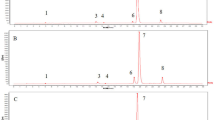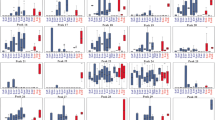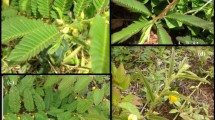Abstract
Cinnamon bark is an important spice worldwide. In this study, the chemical diversity of various commercially available cinnamon barks that differed in their production areas and utility applications (culinary spice or medicines) were investigated by the use of 1H NMR metabolomics. Our results indicated that principle component analysis (PCA) and hierarchical cluster analysis (HCA) of the 1H NMR spectra of the cinnamon bark methanolic extracts including the deduction of their species by nucleotide sequence analysis enabled differentiation of the cinnamon barks according to their species, production areas and utility applications. The constituents of Vietnam cinnamon were found to differ significantly from the other samples investigated based on PCA score plots and HCA constellation dendrograms. Coumarin was found to be a key compound for the discrimination of Vietnamese cinnamon by multivariate analysis of the 1H NMR spectral data and direct comparison of the 1H NMR spectra. In addition, coumarin was quantified using quantitative NMR methods. As a result, coumarin was contained in Vietnamese cinnamon at a higher level compared to other cinnamons. This study indicated that 1H NMR metabolomics could deduce spices, utility, and producing area of commercially available cinnamon barks. Furthermore, combining quantitative 1H NMR methods with 1H NMR metabolomics enable quantification of coumarin in cinnamon bark on a single measurement.




Similar content being viewed by others
References
Hayward JN, McDougall JG, Farag S, Allwood JW, Austin C, Campbell F, Horgan G, Ranawana V (2019) Cinnamon shows antidiabetic properties that are species-specific: effects on enzyme activity inhibition and starch digestion. Plant Foods Hum Nutr 74:544–552
Paliwal R, Madungurum AM, Dahiru N (2018) Phytochemical analysis, phytochemical activity and antibacterial effects of Cinnamon zeylanicum (dalchini) extracts. Int J Eng Sci Res Technol 7:162–170
Farag AM, Labib MR, Noleto C, Porzel A, Wessjohann AL (2018) NMR approach for the authentication of 10 cinnamon spice accessions analyzed via chemometric tools. LWT Food Sci Technol 90:491–498
Chen P, Sun J, Ford P (2014) Differentiation of the four major species of cinnamons (C. burmannii, C. verum, C. cassia, and C. loureiroi) Using a flow injection mass spectrometric (FIMS) fingerprinting method. J Agric Food Chem 62:2516–2521
Shen Y, Jia L-N, Honma N, Hosono T, Ariga T, Seki T (2012) Beneficial effects of cinnamon on the metabolic syndrome, inflammation, and pain, and mechanisms underlying these effects – a review. J Tradit Complement Med 2:27–32
Muhammad JS, Zaidi FS, Shaharyar S, Refaat A, Usmanghani K, Saiki I, Sugiyame T (2015) Anti-inflammatory effect of cinnamaldehyde in Helicobacter pylori induced gastric inflammation. Biol Pharm Bull 38:109–115
Suzuki R, Nakano F, Ohno H, Murakami T, Okada Y, Shirataki Y (2018) Distinguishing Glycyrrhiza species using NMR-based metabolomics. Nat Prod Commun 13:71–73
Suzuki R, Hasuike Y, Hirabayashi M, Fukuda T, Okada Y, Shirataki Y (2013) Identification of a xanthine oxidase-inhibitory component from Sophora flavescens using NMR-based metabolomics. Nat Prod Commun 8:1409–1412
Suzuki R, Takahiro U, Takao R, Shirataki Y (2019) Nor-kurarinone characteristic of Chinese Sophora flavescens. Nat Prod Commun 14:107–109
Suzuki R, Ohno H, Murakami T, Shirataki Y (2020) Improving quality control of yucca extracts used as food additives by screening antimicrobial activity using NMR metabolomics. J Nat Med 74:306–310
Simmler C, Napolitano JG, McAlpine JB, Chen S-N, Pauli GF (2014) Universal quantitative NMR analysis of complex natural samples. Curr Opin Biotechnol 25:51–59
Tanaka R, Shibata H, Sugimoto N, Akiyama H, Nagatsu A (2016) Application of a quantitative 1H-NMR method for the determination of paeonol in Moutan cortex, Hachimijiogan and Keishibukurogan. J Nat Med 70:797–802
Tanaka R, Inagaki R, Sugimoto N, Akiyama H, Nagatsu A (2017) Application of a quantitative 1H-NMR (1H-qNMR) method for the determination of geniposidic acid and acteoside in Plantaginis semen. J Nat Med 71:315–320
Doh EJ, Kim J-H, Oh S, Lee G (2017) Identification and monitoring of Korean medicines derived from Cinnamomum spp. by using ITS and DNA marker. Genes Genom 39:101–109
Ministry of Health, Labour and Welfare of Japan (2016) The Japanese pharmacopoeia, 17th Edn (Ministry Notification No. 64 of Mar 7, 2016), p 1785
Kumar S, Kumari R, Mishra S (2019) Pharmacological properties and their medicinal uses of Cinnamomum: a review. J Pharm Pharmacol 71:1735–1761
Wang YH, Avula B, Nanayakkara NPD, Zhao J, Khan IA (2013) Cassia cinnamon as a source of coumarin in cinnamon-flavored food and food supplements in the United States. J Agric Food Chem 61:4470–4476
Bundesinstitut für Risikobewertung, New insights into coumarin contained in cinnamon. BfR opinion No. 036/2012. Berlin, Germany, 2012. https://www.bfr.bund.de/cm/343/neue-erkenntnisse-zu-cumarin-inzimt.pdf
Ballin ZN, Sørensen TA (2014) Coumarin content in cinnamon containing food products on the Danish market. Food Control 38:198–203
Blahová J, Svobodová Z (2012) Assessment of coumarin levels in ground cinnamon available in the Czech retail market. Sci World J. https://doi.org/10.1100/2012/263851
Sproll C, Ruge W, Andlauer C, Godelmann R, Lachenmeier WD (2008) HPLC analysis and safety assessment of coumarin in foods. Food Chem 109:462–469
Owczarek A, Kłys A, Olszewska AM (2019) A validated 1H qNMR method for direct and simultaneous quantification of esculin, fraxin and (–) epicatechin in Hippocastani cortex. Talanta 192:263–269
Yang L, Li Q, Feng Y, Qiu D (2020) Simultaneous determination of three coumarins in Angelica dahurica by 1H-qNMR Method: a fast and validated method for crude drug quality control. J Anal Methods Chem 2020:8987560
Acknowledgements
This study is supported in part by JSPS KAKENHI Grant Number JP16K08302. We are grateful to Dr. Katsuo Asakura at JEOL Ltd., for his suggestions regarding quantitative NMR (qNMR) methods.
Author information
Authors and Affiliations
Corresponding author
Ethics declarations
Conflicts of interest
The authors declare no conflict of interest.
Additional information
Publisher's Note
Springer Nature remains neutral with regard to jurisdictional claims in published maps and institutional affiliations.
Rights and permissions
About this article
Cite this article
Suzuki, R., Kasuya, Y., Sano, A. et al. Comparison of various commercially available cinnamon barks using NMR metabolomics and the quantification of coumarin by quantitative NMR methods. J Nat Med 76, 87–93 (2022). https://doi.org/10.1007/s11418-021-01554-6
Received:
Accepted:
Published:
Issue Date:
DOI: https://doi.org/10.1007/s11418-021-01554-6




